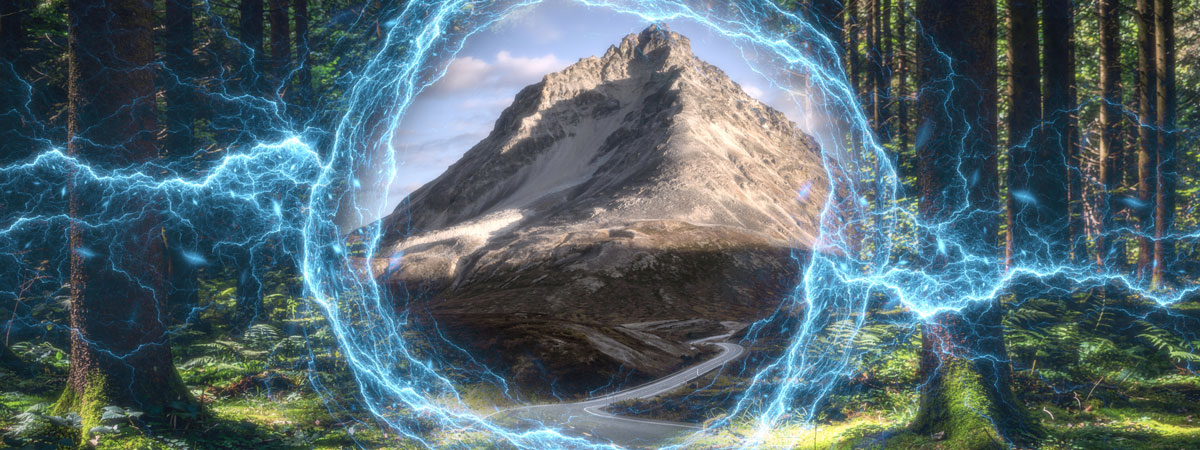The idea of alternate realities has always inspired me to think beyond what’s possible in our three dimensions of time plus space. Writing fantasy brings to mind the possibility of a time and place where physical laws work differently from our own or are more flexible, leading to very different lives for its inhabitants.
I’ve worked some interesting types of alternate realities into much of my work, and I owe a debt to the innovators of genre fiction who preceded me. So, I decided to show my appreciation for the writers who influenced my work and research what inspired them, tracing that lineage back as far as I could.
The earliest examples of alternate realities in fiction
Alternate realities, as we tend to think of them, were born with fantasy fiction in the late 1800s (or, arguably, the 1600s). From the fantasy genre’s inception, authors borrowed extensively from those ancient myths and epics that made references to other realms, like Olympus, Valhalla, and heaven. Often, they took the shape of a Platonic higher reality inhabited by fantastical and magical beings.
Early examples of this in fantasy fiction are Margaret Cavendish’s The Blazing World (1666), Lewis Carol’s Alice’s Adventures in Wonderland (1865), L. Frank Baum’s The Wonderful Wizard of Oz (1900), Lord Dunsany’s The King of Elfland’s Daughter (1924), and Hope Mirrlees’s Lud-in-the-Mist (1926).
Realms of consciousness
At some point, fiction began to explore the possibility of traveling to other Universes by way of some dimension of consciousness. Much of this has been inspired by mysticism, shamanistic religions, dreams, and psychedelic substances.
H. P. Lovecraft’s Dream Cycle is an early example, with a portal to another dimension available only in dreams. (Fuck Lovecraft as a person and for much of his writing, but his stories were influential.)
As a kid in the 80s, I was obsessed with consciousness change. I meditated. My friends and I figured out ways to induce dreams. I practiced yoga and tai chi. I used self-hypnosis tapes that transported my mind to beautiful wooded places of pure peace.
As a gullible kid fascinated by consciousness change, I spent a lot of time in the New Age section of Waldenbooks and accumulated a nice collection. Many of these books claimed that the right state of mind could serve as a key to other dimensions of reality.
My trip to the other realm
One book promised the ability of astral projection by following a deep relaxation technique. The idea was to get the body so relaxed that it would release the spirit…or that’s how I remember it. After over an hour of patient, repeated progressive relaxation, attending to every muscle group, I began to dream. Except I wasn’t asleep. My body had melted into the mattress, and just as promised, my mind was free. I found myself lifted from my body and floating into space. I looked down on Earth for a while, then turned and explored places of utter darkness and places of sparkling lights swirling in symphonies of color.
That’s when I realized the enormity of the imagination’s power. I hadn’t left my body, and I knew it. The experience was a creation of my mind, similar to (but not quite the same as) a lucid dream. It fascinated me that I had created a profound and realistic experience for myself with a simple recipe: slow and steady breathing, progressive relaxation, and patience.
It occurred to me how incredible my mind was, that it could generate and cast an entire universe across my field of vision, give it sound, and make me weightless as I floated through it. I could inhabit it, experiencing it subjectively, finding genuine novelty and surprises along the way.
So, of course, that’s the sort of exploration that often makes its way into my fiction.
Alternate realities get scientific
Eventually, science fiction authors developed their version of portal fantasy, exploring speculative physics and using scientific vernacular like “parallel dimensions.” These realms would be revealed if we could travel on a new dimensional axis, outside the familiar axes of time and space. Murray Leinster’s Sidewise in Time (1934) was among the first science fiction novels to explore parallel dimensions.
DC Comics’ The Flash #123 popularized this concept in 1961, introducing the 52 numbered universes that DC fans still know today.
Alternate histories
I became a fan of Phillip K. Dick’s work in my 20s, and The Man in the High Castle was one of my first exposures to his work. The story takes place in an alternate history in which the Axis won WWII, and the U.S. has been split into two territories, with the East controlled by Nazi Germany and the West controlled by Japan.
The first known story of alternate history was in the last century BCE when historian Livy imagined an alternate 4th century BC where Alexander the Great lived to attack Europe.
Alternate histories are helpful, sometimes, to imagine how our world and our lives might be different if some small moment of chance had gone another way. It often helps me appreciate my life, as any slight deviation might have led to a world in which my daughter never existed. Writers learn quickly how a small shift can have immense consequences on the events that follow.
Michael Moorcock: the “multiverse” is born
William James coined the term “multiverse” in 1895, but he was referring to our chaotic universe as a multiverse, lacking order due to its “plasticity and indifference.”
The word didn’t catch hold at the time, but later, Michael Moorcock became the first author to use the term in fiction—this time to describe a multiplicity of physical, coexisting universes. He introduced the concept with this sentence from The Blood Red Game in 1963:
“Jewelled, the multiverse spread around him, awash with life, rich with pulsating energy.”
Moorcock’s multiverse is, in my view, the most richly developed. His cosmology is an eternal struggle between primal polarities of war and chaos, order and entropy.
It’s also worth noting that Moorcock drew the Symbol of Chaos that many will recognize in the early 1960s when he worked on the first Elric stories.

Along with the multiverse, Moorcock introduced the idea of the Eternal Champion, a being who may be born in any universe when he’s needed to restore the Cosmic Balance between the cosmic forces of law and chaos.
Eric of Melniboné was the most famous incarnation of the Eternal Champion, who tore down the barrier holding back Chaos, causing a battle between Law and Chaos that destroyed his world, making way for the Cosmic Balance to create our world.
SagaBorn’s Navirim and the In-Between
SagaBorn is a classic-style simplified pen-and-paper RPG that I’ve had the privilege to be a part of, and in its creation, we’ve been inspired by all of the examples above.
In SagaBorn, we don’t travel from reality to reality, preferring to focus on one. Instead, we bring beings from other realms into Uteria. Some are dark creatures from the neighboring Navirim, the dream world, while others migrated long ago from forgotten places by way of forgotten technologies.
The people of Uteria have a tenuous connection to the Navirim, where reality is incoherent to the human mind and is inhabited by terrifying creatures of great power who sometimes find their way into Uteria in the flesh.
If one travels between realities, that implies there’s some space to transverse, and we begin to wonder what lies between one realm and another. We called that place the In-Between. This is a place where one can become trapped if a journey between realms is unsuccessful. It’s neither entirely solid nor formless. It would be a disorienting life for one pulled into this place, though a native-born would take it for granted, just as we take our physical reality for granted.
Alternate realities in my stories
I was always drawn to strange worlds accessed by shifts in the mind. I remember being fascinated by movies like A Nightmare on Elm Street 3: The Dream Warriors, Altered States, and Videodrome. These movies were about strange, beautiful, or terrifying worlds that could be entered through a portal of the mind. This seemed far more fascinating than a physical door to a new land because the possibilities stretched as wide as the imagination, and the gateway was immediately accessible.
In The Mythos Cycle, I explore what seems to be a higher dimension of reality, from which all of time and space can be seen from an outside perspective. Whether this is a real place or entirely imaginary is up to the reader to decide, but it’s a real experience for the explorer.
Alternate perspectives are alternate universes
Just as my mind has created interesting realities, so does everyone’s at every moment. I think it’s important to remember that if there are 8 billion people, then there are 8 billion subjective universes plus every other consciousness that has ever existed.
Imagine, for a moment, a universe without a mind to observe it. You can’t because the universe, as we know it, only exists in our minds, generated by our biology and the narrow ranges of sensory data we perceive to help us survive our immediate environments. A universe without an observer looks, sounds, smells, tastes, and feels like nothing. It’s just a bunch of stuff.
So to change the universe, change the mind. To expand the universe, expand the mind.
If there’s one central theme to all of my work, including this grimoire, it’s this. We can explore alternate universes without going anywhere.

